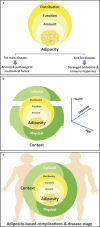The ABCD of Obesity: An EASO Position Statement on a Diagnostic Term with Clinical and Scientific Implications
- PMID: 30844811
- PMCID: PMC6547280
- DOI: 10.1159/000497124
The ABCD of Obesity: An EASO Position Statement on a Diagnostic Term with Clinical and Scientific Implications
Abstract
Obesity is a frequent, serious, complex, relapsing, and chronic disease process that represents a major public health problem. The coining of obesity as an adiposity-based chronic disease (ABCD) is of particular relevance being in line with EASO's proposal to improve the International Classification of Diseases ICD-11 diagnostic criteria for obesity based on three dimensions, namely etiology, degree of adiposity, and health risks. The body mass index as a unique measurement of obesity does not reflect the whole complexity of the disease. Obesity complications are mainly determined by 2 pathological processes, i.e., physical forces (fat mass disease) as well as endocrine and immune responses (sick fat disease), which are embedded in a cultural and physical context leading to a specific ABCD stage.
Keywords: Adiposity; Comorbidities; Dysfunctional adipose tissue; Noncommunicable diseases.
© 2019 The Author(s) Published by S. Karger AG, Basel.
Figures

References
-
- Frühbeck G, Gómez-Ambrosi J. Control of body weight: a physiologic and transgenic perspective. Diabetologia. 2003 Feb;46((2)):143–72. - PubMed
-
- Gluckman PD, Hanson M, Zimmet P, Forrester T. Losing the war against obesity: the need for a developmental perspective. Sci Transl Med. 2011 Jul;3((93)):93cm19. - PubMed
-
- Frühbeck G, Toplak H, Woodward E, Yumuk V, Maislos M, Oppert JM, Executive Committee of the European Association for the Study of Obesity Obesity: the gateway to ill health - an EASO position statement on a rising public health, clinical and scientific challenge in Europe. Obes Facts. 2013;6((2)):117–20. - PMC - PubMed

